| □ | This is why it all ends up here at the CSID Zones Form: |
| c. | A Technician installs that contracted security system. |
| e. | Invariably, each Subscriber's Alarm System is a little bit different than the standard setup (aren't they always?), so some custom CSID Zone definitions are required. |
| □ | This CSID Zones Form provides the means to identify Exceptions to the standard predefined Panel Zones for the Communicator Format programmed into the Control Panel installed at the Subscriber's Premises. |
| • | Communicator Formats are entered to establish the transmission formats of the Communicators your Company is installing. |
| • | The default Panel Zones (for the Selected Communicator Format that was installed in the Subscriber's Alarm System) may not match the actual purpose, description, and/or notification rules of the Alarm Signals that will be sent by this specific Subscriber. |
| • | Here are six reasons why you may need to define one or more CSID Zones to replace the default Panel Zone information predefined for the selected Communicator Format: |
| 1. | More information is needed to clarify a particular event or alarm than what is provided in the default Panel Zone record. |
| 2. | The default Panel Zone record's Signal ID (and/or Physical Zone) is being used for a completely different purpose for this CSID. |
| 3. | There are multiple - non-standard - Physical Zones for the default Panel Zone record's Signal ID. |
| 4. | The Subscriber's default Call Order is not sequenced correctly for some Alarm Signals. |
| 5. | Specific processing steps will be different than those defined in the default Panel Zone record. |
| 6. | There may be a need to define another Signal ID (and perhaps also a Physical Zone) which is not actually sent from the Receiver, but rather is defined to alert an Operator to perform some special task for a specific Subscriber, or for the Central Station itself (see "User Defined Signal IDs" below). |
| • | Generally speaking, when an Alarm Signal is received: |
| ▪ | to properly interpret that signal, the system searches the CSID Zones table first for the appropriate alarm processing information. |
| ▪ | If no matching Signal ID - and if available - Physical Zone combination is found there, it then looks at the Panel Zones that were predefined for this Subscriber's Communicator Format. |
| ▪ | If neither source (and some other variables outlined below) contains the information for the Alarm Signal that was transmitted, is it reported as an Invalid Alarm. |
| • | Therefore, the Panel Zones Form allows you to define the default information for the most common purpose of the Alarm Signals sent by your Subscribers. |
| • | Information representing Exceptions to these Panel Zones are defined for Specific Subscribers using the CSID Zones Form. |
| • | To be precise, the Signal Processing Order in which the Signal Processing Application (SPA) searches for, and validates, an incoming Alarm Signal is as follows: |
| 1. | Exact Match on a CSID Zone Override (Signal ID & Physical Zone). |
| 2. | Exact Match on a CSID Zone (Signal ID & Physical Zone). |
| 3. | Exact Match on a Panel Zone (Signal ID & Physical Zone). |
| 4. | Partial Match on a CSID Zone (Signal ID). |
| 5. | Partial Match on a CSID Zone using the Wild Card feature (Signal ID). |
| 6. | Partial Match on a Panel Zone (Signal ID). |
| 7. | Signal ID from the Receiver + CSID Zone's Physical Zone. |
| 8. | Signal ID from the Receiver + Panel Zone's Physical Zone. |
| 9. | Reported as an Invalid Alarm. |
| □ | User Defined Signal IDs: |
| • | When a Signal ID (and optionally a Physical Zone) is required, which cannot be, and so is not, actually transmitted from the Subscriber's Control Panel. |
| • | This type of CSID Zone record is entered for the purpose of defining a required task, and must match a special Event record, that triggers an Alarm Signal which reminds an Operator to perform that required task. |
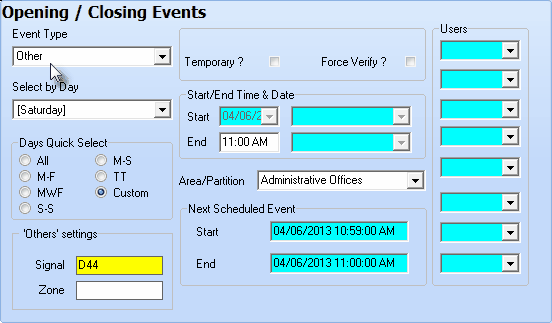
Opening / Closing Events Form - Other Event Type
| • | See Other Events for information on entering the matching 'Other' Settings on the Events Form. |
| ► | Note: This 'Others' Settings feature is quite different than the "Other" Dispatch selection explained below. |
| • | At the bottom of this Form, Select the Subscriber Panel's CSID for which CSID Zone information must be defined |
| • | On the Central Station Data Forms Quick Access Menu, Click the CSID Zones to view the (example) Form shown below. |
| • | The Edit View tab is selected by default. |
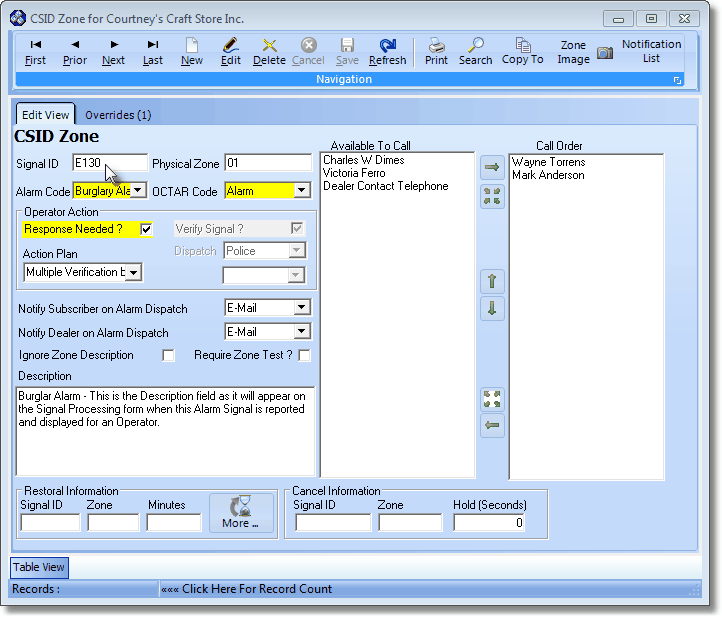
CSID Zone Form
| • | This CSID Zone Form may be Re-sized by Dragging the Top and/or Bottom up or down, and/or the Right side in or out. |
| • | Navigation Menu - The Navigation Menu is located at the top of the CSID Zone Form. |

| • | This Navigation Menu provides the normal Record Movement, New, Edit, Delete, Cancel, Save, and Refresh options; as well as the Print, Search, Copy To, Zone Image, and Notification List options (see the "Other Icons on the Navigation Menu for this CSID Zones Form" section below for information about the Print, Search, Copy To, Zone Image, and Notification List options). |
| • | Edit View tab - The details of the currently selected CSID Zone record are displayed below the Navigation Menu within the Edit View tab at the center (Main Body) of the CSID Zone Form. |
| • | Table View tab - A tabular (spreadsheet style) Table View of the currently defined CSID Zones is accessible by Clicking the Table View tab at the bottom of the CSID Zone Form. |

| • | To display a specific CSID Zone record in the Record Editing section, Click on that record within the Table View section, or use the Search Icon (see the "Other Icons on the Navigation Menu" section later in this chapter). |
| • | This Table View information may be Pinned in Place by Clicking the Pin Icon on the right. |

CSID Zone Form - with Table View tab Pinned Open
| ▪ | You may Un-Pin this Table View by Clicking the Pin Icon again. |
| ▪ | Click on any listed record to display that information in the center (Main Body) of the Form. |
| • | There are six columns of data in this CSID Zones Record Listing: |
| 1) | ID - The unique ID assigned by the system when this record was initially saved. |
| 2) | Signal ID - The Signal Identifier transmitted by the Alarm System for this CSID Zone. |
| 3) | Zone - The Physical Zone transmitted by the Alarm System for this CSID Zone. |
| 4) | Alarm Code - The Condition Code representing the type of signal or event transmitted by the Alarm System for this CSID Zone. |
| 5) | OCTAR - The code letter indicating that this CSID Zone represents either an Open, Close, Test, Alarm or Restoral signal. |
| 6) | Description - The description of event. |
| • | Each column's Header Name describes the data contained in that column. |
| ▪ | Clicking on a Header Name will set the order in which the CSID Zones will be listed. |
| ▪ | Clicking on the same Header Name will set the order in the opposite direction (ascending vs. descending). |

| ▪ | The Header Name which is determining the Order of the listed data, will have an Icon displayed next to that Header Name to indicate that Order. |
| □ | Defining a CSID Zone: Click the  Icon to start a CSID Zone entry in the Record Editing section. Icon to start a CSID Zone entry in the Record Editing section. |
| • | "Wild Cards" may be used when defining the Signal ID. |
| ▪ | Wild Cards are specific characters that represent a range of substitution possibilities for Signal Identifiers when an Alarm Signal, whether sent from the Receiver or entered as a Manual Alarm, is being interpreted by SPA. They include: |
| o | Underscore - The underscore mark (" _ ") may be inserted anywhere within the Signal Identifier field to represent that another (any other) character may be received in that same position. |
| o | Percent Sign - The percent sign (" % ") may be inserted at the end of the Signal Identifier field to represent that any number of additional characters, from that position on, may be received. |
| • | Physical Zone - Enter the Zone Code, if one is transmitted along with the Signal Identifier. |
| • | For the SIA Format Only - When the additional modifiers: PT (point), ID (user id), or RT (rf point) are received, the number that follows these modifiers will be placed in the Physical Zone field appended to actual Physical Zone number. |
| • | If a Wild Card was used in the Signal ID, a Physical Zone must be entered. |
| • | Alarm Code - Use the Drop-Down Selection List provided to Choose the appropriate Alarm Condition Code. |
| • | OCTAR Code - Use the Drop-Down Selection List provided to Choose (the list is shown below) the type of signal or event you are defining. |
| • | Operator Action - If this is a Active Signal (one that needs some type of Operator Response), indicate the Alarm Processing step(s) the Operator is to take when this Alarm Signal is received. |
| • | Response Needed? - Check this box when some type of Operator Response is required. |
| ▪ | Whether or not the Response Needed? box is Checked, the Call List section with the Available To Call and Call Order columns will be accessible. |
| ▪ | If Response Needed? is not Checked, it will be considered a Passive Signal (one that does not need any specific Operator Response) and no other Operator Action or Notification options will be available. |
| ▪ | Note: For Communications Module Users - When using the Off Test Warning feature (which notifies a Technician via Email that an Account which (s)he placed On Test is about to come Off Test), to have an Operator also get this Off Test Warning Signal, Check the Response Needed? box. |
| • | Verify Signal? - Check if this Signal is to be Verified by telephoning the premises in advance of any Dispatch, or other Notification process.. |
| • | Dispatch - If this is an Active Signal, use the Drop-Down Selection List to Choose (the list is shown below) the type of response that is needed. |
| ▪ | Fire = Notify the appropriate Fire Department of the reported Fire Alarm Condition. |
| ▪ | Medical = Notify the appropriate Medical Emergency Response Service of the reported Medical Alarm Condition. |
| ▪ | Police = Notify the appropriate Police or Sheriff's Department of the reported Burglary, Silent or Hold-Up Alarm Condition. |
| ▪ | Other = Notify the appropriate Responsible Person responsible for responding to the reported Emergency Condition (also see Other Call below). |
| ▪ | None = No specific "Dispatch" related Response is needed (see Note below). |
| a) | The Comments entered on the Central Station Data Form should clearly reflect that a Guard Response is required for any Burglar Alarm signals. |
| b) | The CSID Zone records defining these events should be Checked Response Needed? and have <Other> selected for the Dispatch type. |
| d) | Select the record representing that Security Company when defining who is contacted for the <Other> response (see "Other Call" below). |
| e) | Be sure that the CSID Zone's Description field also clearly reflects this response requirement (see "Other Call" below). |
| • | Other Call - If the type of Dispatch Response that was selected above is <Other>, use the Drop-Down Selection List (immediately below the Dispatch box) to Choose the appropriate Name, from the Subscriber's People To Call table, of who is to be notified. |
| • | Action Plan - If there is a Response Needed for this Alarm Signal and the normal Operator Guided Response is incapable of providing the appropriate instructions for the Operator, you may instead use a predefined Action Plan to dictate the exact Signal Processing steps that are required. |
| ▪ | Use the Drop-Down Selection List to Choose the appropriate Action Plan for processing this Alarm Signal. |
| ▪ | You may Right-Click in the Action Plan field to set the order of the Drop-Down Selection List list by Choosing either ID or Description order, as desired. |
| • | Assign the appropriate Automated System Action Plan and optionally a Signal ID and/or Physical Zone to any CSID Zone that will be processed by the MKSASP application. |
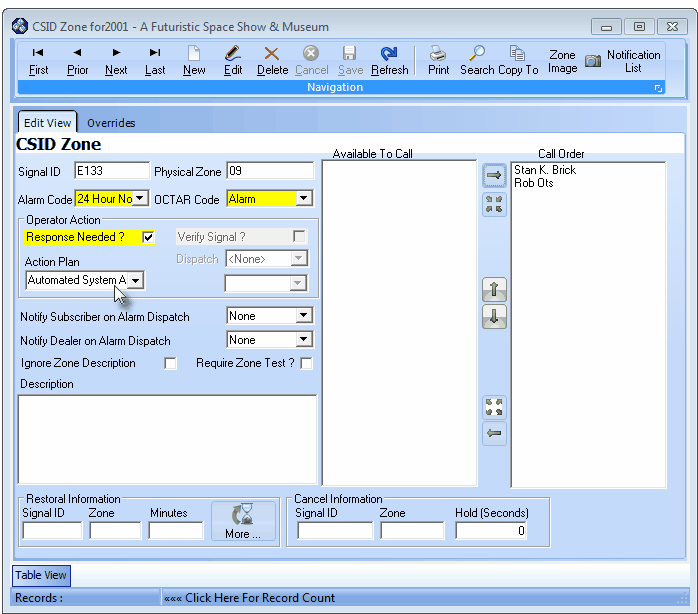
CSID Zone Form - with Automated System Action Plan
| ► | Note: The information below is specific to those Signals which are to be processed by the MKSASP application: |
| ▪ | Signal ID - Enter the specific Signal Identifier for this Signal and/or |
| ▪ | Physical Zone - Optionally, enter the Zone Code, if one will be transmitted along with the Signal Identifier. |
| ▪ | Alarm Code - Use the Drop-Down Selection List provided to Choose the appropriate Alarm Condition Code. |
| ▪ | OCTAR Code - Use the Drop-Down Selection List provided to Choose Alarm. |
| ▪ | Response Needed? - Check this box when the Response is to be provided by the MKSASP application. |
| ▪ | Action Plan - Because there is a Response Needed for this Alarm Signal - which will be provided by the MKSASP application - a predefined Automated System Action Plan is required. |
| o | Use the Drop-Down Selection List to Choose the appropriate Automated System Action Plan Plan for processing this Alarm Signal. |
| ▪ | Call Order - Set the Call Order with the People To Call who are to be notified of this Automated System Action Plan related Signal. |
| • | Notify Subscriber on Alarm Dispatch - Use the Drop-Down Selection List to Choose the Subscriber's notification preference. |
| • | Notify Dealer on Alarm Dispatch - Use the Drop-Down Selection List to Choose the Dealer's notification preference. |
| • | Ignore Zone Description - This special setting is used to properly process certain types of Supervisory Signals. |
| • | When a Supervisory Signal is received, it generally consists of a Signal Identifier (which identifies the Problem or Situation) and also frequently includes a Physical Zone (which actually does not represent a "real" Zone within the Alarm System). |
| • | Certain Communicator Formats may add a Zone Code to the Signal Identifier transmitted for some Supervisory Signals |
| ▪ | There is a possibility that this Signal Identifier + Zone Code (Physical Zone) combination might be misinterpreted as an Actual Zone in the Alarm System in use (e.g., LB+001). |
| ▪ | This would occur when the Signal Identifier in the Panel Zones record is matched with a Physical Zone identified in a CSID Zones record creating something like " Low Battery/Front Door" when there is no battery at the front door (it's in the Control Panel). |
| • | Check this box to ignore the Zone Code (Physical Zone) and it's Description, and instead use the default Description field information defined in the Panel Zones record when this Supervisory Signal is displayed for an Operator. |
| • | Description - Provide a clear, concise description of this Signal ID and/or Physical Zone. |
| ► | Note: As noted above, for Accounts using a Security Company for their Burglar Alarm Response, this Description field should also clearly reflect this response requirement. |
| • | Click the  Icon to to record this CSID Zone. Icon to to record this CSID Zone. |
If the VerifyZones option in the Company Settings dialog is set to False ("F") - regardless of whether or not any Zone Test? box is Checked on any CSID Zones Form - neither the Unverified Zones dialog, nor the related Zone Test Verification Report, will be available.
| • | All Zones that are displayed may be Reset to a Waiting ("W") Test Status, if needed. |
| □ | Restoral Information Overview (also see the separate Restoral Information chapter for more detailed information): |
| • | For an Alarm Event or Signal which requires that a subsequent Restoral Signal also be received (when everything has "restored to normal"): |
| a. | Instead of Checking the Response Needed? box, complete the Restoral Information section (described below). |
| b. | When this CSID Zone Signal is received, because there is Restoral Information defined, it will immediately place the Signal into the Subscriber's Alarm History while waiting for that Restoral Signal. |
| c. | The amount of time that the system will wait for the Restoral Signal to be received, before creating the Failed to Restore Signal, is measured (and entered) in Minutes. |
| d. | If the Alarm Event or Signal, that indicates this CSID Zone has been successfully restored, is not received within the required number of Minutes, an FR* Alarm Condition Alarm Event will be generated automatically by MKMSCS. |
| e. | Because of this, if the default Panel Zone with this Restoral Information is not appropriate, a separate FR* CSID Zone record must also be defined as follows. |
| ▪ | Response Needed? - Check in the Response Needed? box of the FR* CSID Zone entry. |
| ▪ | FR* - You must also create an additional "Failed To Restore" CSID Zone - with FR* entered as the Signal Identifier and also with the FR* Alarm Condition |
| ▪ | No Physical Zone information should be entered. |
| ▪ | Operator Action - Define the appropriate Operator Guided Response (i.e., Response Needed?, Verify Signal?, and Dispatch information) for this FR* CSID Zone entry. |

Operator Action for Operator Guided Response steps
| ▪ | Optionally, because this additional FR* record is a Response Needed? "Failed To Restore" Alarm Signal, if the fields that identify the normal Operator Guided Response (i.e., Response Needed?, Verify Signal?, and Dispatch as shown in the illustration immediately above) are not capable of providing the appropriate instructions for the Operator, you may instead use a predefined Action Plan to dictate the exact Signal Processing steps that are required. |

Operator Action requiring use of an Action Plan
| ▪ | If you do need to assign an Action Plan, use the Drop-Down Selection List provided to Choose that Action Plan for processing this "Failed To Restore" Alarm Signal. |
| f. | The Restoral Signal record containing the Signal ID (and optional Physical Zone) that is transmitted to indicate that everything has "restored to normal", must be either an existing Panel Zone or be defined as an additional CSID Zone record with the following data: |
| ▪ | Response Needed? - Do not Check the Response Needed? box because this is actually a Passive Signal. |
| ▪ | Signal ID - Enter the corresponding Signal ID representing the Restoral of the originating CSID Zone's Signal ID. |
| ▪ | Zone - Optionally, enter the Physical Zone representing the Restoral of the originating CSID Zone's Physical Zone. |
| ▪ | No data is entered in any of the Restoral Information fields. |
| ► | Note: If the Signal ID (and optionally the Physical Zone) of the Restoral Information identified above is not defined as a separate and appropriate Panel Zone, or a special CSID Zone created for that purpose: |
| i. | When this Restoral Signal is received, the Restoral Information's Signal Identifier (and optional Physical Zone) combination would be considered an Invalid Alarm. |
| ii. | Furthermore, the proper recording of the Restoral will not occur, even if it is transmitted within the proper timeframe. |
| • | Restoration Information: Enter the data requested below to identify the appropriate Restoration Information for this CSID Zone. |
| • | Response Needed? - You do not Check the Response Needed? box for this CSID Zone (which is the one reporting the problem). |
| ▪ | This is because by completing these Restoration Information fields, it eliminates the need for an immediate response. |
| ▪ | Either the required Restoral Signal will be received within the allowable timeframe (thus completing the Signal automatically), or the "Failed To Restore" Alarm Signal will be generated automatically. |

Restoral Information
| • | Signal ID - Enter the corresponding Signal ID representing the Restoral of the CSID Zone's Signal ID entered above. |
| • | Zone - Optionally, enter the Physical Zone representing the Restoral of the CSID Zone's Physical Zone entered above. |
| • | Minutes - If this Alarm Condition is not to be reported to the Operator until after a specified number of minutes has passed (allowing the Subscriber's system to restore to its normal mode in a reasonable period of time), enter that number of minutes here. |
| ▪ | If the Restoral signal has not been received within this time frame, a Failed to Restore (FR*) Alarm Event will be generated for the Operator indicating that the original Event or Alarm Signal was not restored within the appropriate time frame. |
| ▪ | Additional Restoral Information may be entered (by Clicking the More... button), if required (see Restoral Information for more information). |
| • | This Restoral Information and the Cancel Information (see below) are also included with the CSID Zones on the Subscriber Information Form Report. |
| □ | Cancellation Information Overview: |
| • | For an Alarm Event or Signal which has a corresponding Cancel (Abort) Code that will transmitted by the Subscriber's communicator via a system reset/disarm action on their part. |
| a. | The time the system waits for the Cancellation Signal to occur is measured (and entered) in Seconds. |
| b. | The Alarm Signal is automatically placed on Hold in the Alarm Stack until that number of Seconds has passed. |
| c. | If the Cancel Signal is received within the designated timeframe, the original Alarm Signal is taken off of Hold, and Internally completed. |
| ▪ | The Alarm Signal is Logged into the Subscriber's Alarm History table with the Cancel (Abort) Code information included. |
| d. | If not Canceled within that time period, the Alarm Signal, which was placed on Hold in the Alarm Stack, will be reset to a Pending Alarm Signal. |
| ▪ | The Alarm Signal is sent to the next available Operator in the normal manner. |
| e. | In addition, the actual Cancel Signal record, containing the Signal ID (and optionally Physical Zone) that is transmitted, must also be defined as a CSID Zone. |
| ▪ | Because this is a Passive Signal, the Response Needed? box should not be Checked for this Cancel Signal record. |
| ► | Note: It is important to know that: |
| i. | If an Operator manually pulls an Alarm Signal from the Alarm Stack that was previously placed on Hold pending receipt of the Cancel (Abort) Code, |
| ii. | Then, if that Operator manually places it back on Hold, |
| iii. | If (when) the Cancel (Abort) Code is subsequently received, it will cannot be processed automatically. |
| iv. | It must be manually completed by an Operator thereafter. |
| • | Cancellation Information: Enter the data requested below to identify the appropriate Cancellation Information for this CSID Zone. |

| • | Signal ID - Enter the specific Signal Identifier that would be displayed for the Operator that would indicate that the previously reported emergency condition, defined above, has been canceled by the Subscriber via a system reset/disarm action on their part. |
| • | Zone - Enter the Physical Zone Code, if one is transmitted with the Signal Identifier, that would be displayed for the Operator that would that would indicate that the previously reported physical zone code, defined above, has been canceled by the Subscriber via a system reset/disarm action on their part. |
| • | Hold (Seconds) - Enter the number of seconds that the originating Alarm Signal should be placed on Hold (automatically) while awaiting a possible Cancel (Abort) Code from the Subscriber. |
| • | Click Save ("ü") to record your entry. |
| • | This Cancel Information and the Restoral Information (see above) are also included with the CSID Zones on the Subscriber Information Form Report. |
| □ | (Re-)Setting the Call List Order - Each Alarm Signal may have the Subscriber's default Call List Order altered for a specific signal based on that Subscriber's needs. |
| • | This Call Order may be established for every Subscriber Panel CSID installed for every Subscriber on a case by case basis as outlined below: |
| 3. | The specific Call Order established for an individual CSID Zone entered for a Subscriber Panel CSID. |
| • | Available To Call - This list contains the Global Call List members (see above) for the CSID for which this CSID Zone is created, and represents the default order in which Operator Notifications should proceed until someone is successfully notified. |

| • | As a Global Call List, the list of Names in the Available To Call column may contain all of the following, if defined: |
| ▪ | People To Call - The Subscriber's People To Call for this CSID and/or |
| ▪ | Call List of Dealer - The Names associated with a CSID assigned to the Dealer for whom you are providing monitoring services this Account, which is identified in the Subscriber Panels section of the Central Station Data Form. |
| • | Call Order - This column displays the re-set order - for this specific CSID Zone - in which Operator Notifications should proceed until someone is successfully notified. |
| • | Select a Name from the Available To Call column and Click the right arrow ð to move that Name to the Call Order column. |
| • | To move all Names from the Available To Call column to the Call Order column Click the top four-arrow cluster. |
| • | You may move Names up and down the Call Order column by Selecting them, and then Clicking either the up or down arrow, as needed, to relocate then to the desired position. |
| • | Select a Name from the Call Order column and Click the left arrow to move that Name to the Available To Call column. |
| • | To move all Names from the Call Order column to the Available To Call column Click the bottom four-arrow cluster. |
| • | Click the Save ("ü") to record the revised Call List Order for this CSID Zone. |

| • | Search CSID Zones - If you want to look up a specific CSID Zone, Click the Search at the top of the Form. |
| • | Search By - Select the method you'll use for this search with the Drop-Down Selection List provided. |
| ▪ | Description - Search by the CSID Zone's Description. |
| ▪ | Signal - Search by the Signal ID. |
| ▪ | Zone - Search by the Physical Zone. |
| ▪ | ID - Search by the actual Record Number |
| • | Search Value - Enter the appropriate characters to locate the desired CSID Zone. |
| • | Click on the desired CSID Zone record. |
| • | Click OK to select the record and return to the CSID Zones Form. |

| • | Print - Click this Print Icon to create a simple listing of the CSID Zones defined for this Subscriber. |
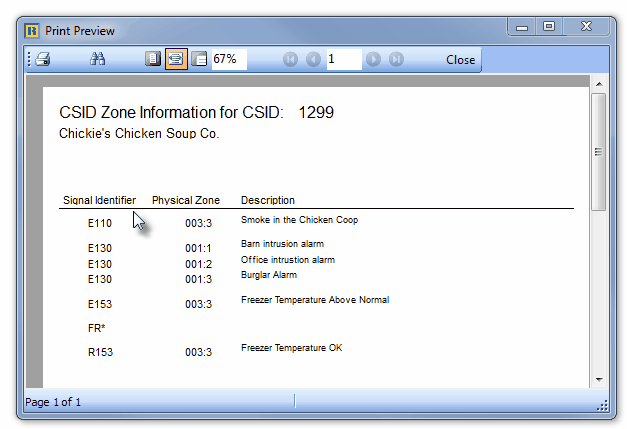
Print Icon - CSID Zone Information Report - Print Preview

| • | Click the Copy To  |
| • | It will display the Search CSID dialog. |
| • | Search By - Select the method you'll use for this search with the Drop-Down Selection List provided. |
| ▪ | CSID - Search by the CSID. |
| ▪ | ID - Search by the actual internal record number. |
| ▪ | Name - Search by the Subscribers Name. |
| • | Search Value - Enter the appropriate characters to locate the desired Subscriber to which you want to copy the currently selected CSID Zones. |
| • | Click on the desired Subscriber's CSID record. |
| • | Click OK to select the record to copy to, and then return to the CSID Zones Form. |

| • | Zone Image - You may add an image file - which will be available to the Operator - illustrating this specific CSID Zone. |
| • | Click the Zone Image button. |
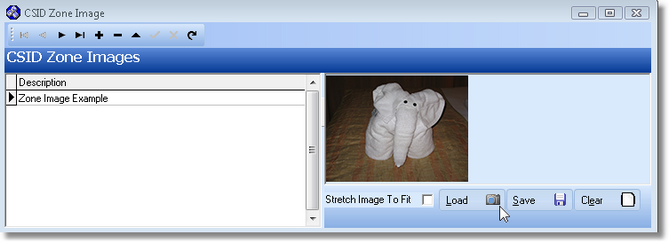
CSID Zone Images dialog
| • | Add - Click Add ("+") to start loading Zone Image . |
| • | Stretch Image to Fit - Click this box if the image you will select is small, and you want it to fill the allowable space. |
| • | Description - Enter a brief description of the image. |
| • | Load - Click the Load button. This will display the standard Windows® Files Locator dialog. |
| ▪ | The Image file you choose must be a ".BMP" file saved with 256 colors (or Less) and be no larger than 64K. |
| ▪ | The file representing your CSID Zone must be on your Computer (or, if you using a Networking System, on the File Server where MKMS is installed). |
| • | Save - Click the Save button to save the currently selected image. |
| • | Clear - Click the Clear button to remove the currently selected image. |

| • | Notification List - For Communication Module users, each CSID Zone (and Override) may have an additional Notification List for Paging and/or Emailing an Alarm or Event Signal Notification of this event, as needed. |
| • | Click the Notification List Icon on the Navigation Menu. |
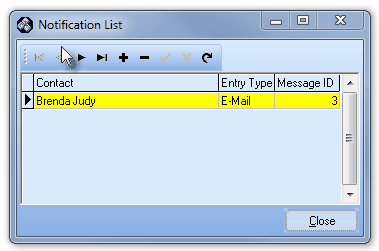
Notification List dialog
| • | Contact - Use the Drop-Down Selection List to Choose the person to contact from those entered on the Communications tab of the People To Call Form for this Subscriber Panel CSID. |
| • | Entry Type - Use the Drop-Down Selection List to Choose the type of message (by Pager or Email) to be sent. |
| • | Message ID - Use the Drop-Down Selection List to Choose the appropriate Predefined Message you want transmitted when the event occurs. |
| • | Click the Save ("ü") to record the Notification List entry. |
| □ | CSID Zone Overrides - The Overrides feature for CSID Zones allows you to modify the default CSID Zone procedures based on certain Days, or Times within those days, including Signal Processing Procedures, Action Plans, and Restoral and Cancel Information that was established for the selected CSID Zone. |
| • | See Signal Processing Order to better understand how SPA and MKMSCS attempt to validate an Alarm ( Event, Test, Restoral) Signal before declaring it an Invalid Alarm. |
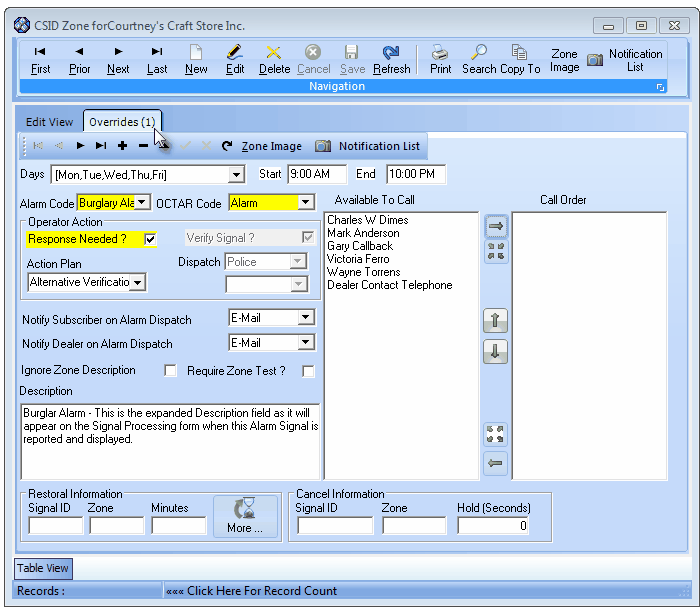
Overrides tab on the CSID Zones Form











![]()

![]()






![]()
![]()

![]()
![]()

![]()

